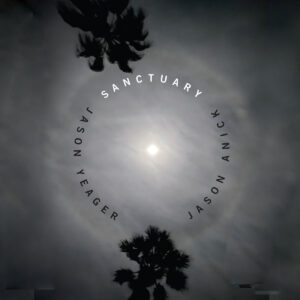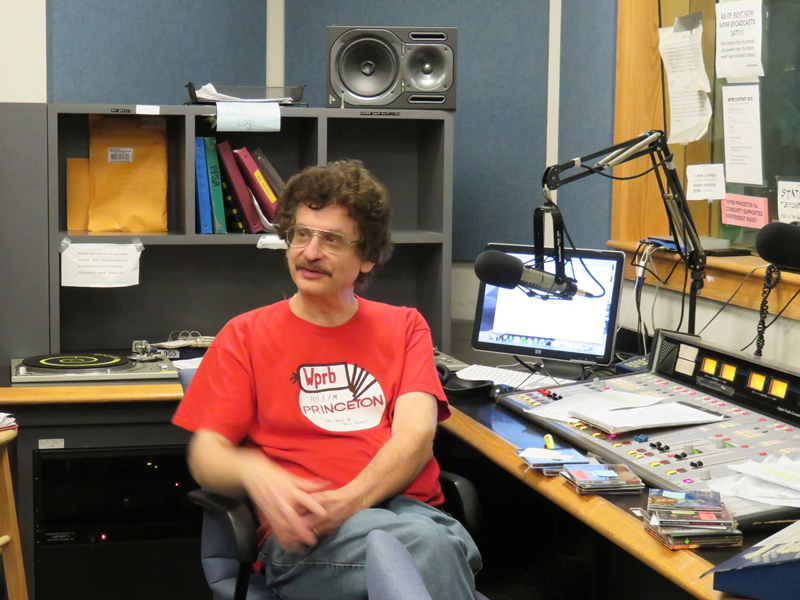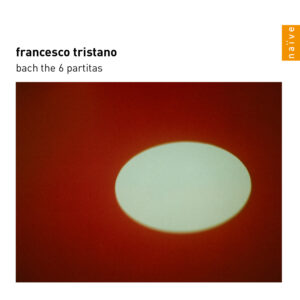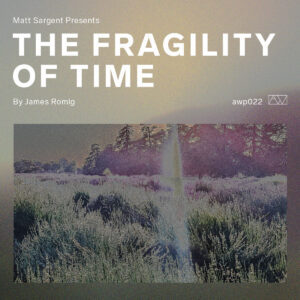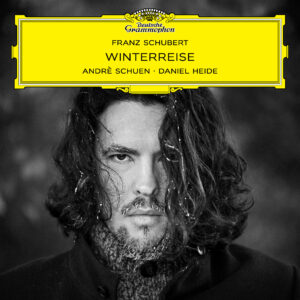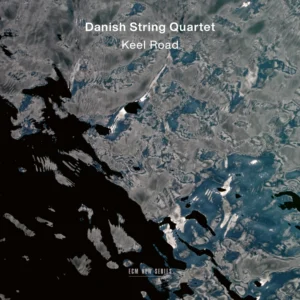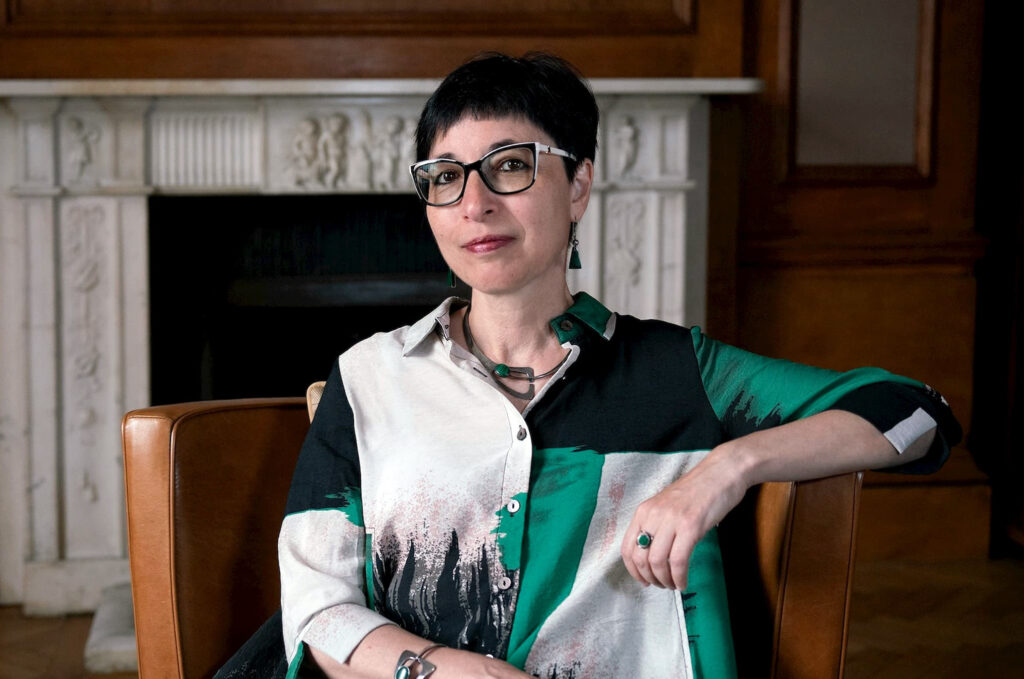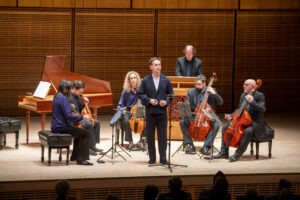
Two Early Music Ensembles Visit New York
Iestyn Davies, countertenor, Fretwork, viols, and Silas Wollston, organ and virginal, Carnegie Hall’s Zankel Hall, December 3rd, 2024
The Tallis Scholars, presented by Miller Theatre’s Early Music Series at Church of St. Mary the Virgin, December 5th, 2024
NEW YORK – This past week’s concert schedule featured two early music ensembles, one specializing in early baroque music, and the other known for renaissance repertoire but presenting a more wide-ranging program.
The countertenor Iestyn Davies is a highly regarded interpreter of Handel’s operas. He also appeared in Claire van Kempen’s play Farinelli and the King, which bowed at London’s Globe Theatre and on Broadway. At Carnegie’s Zankel Hall, he joined the viol quintet Fretwork – Emilia Benjamin, Jonathan Rees, Joanna Levine, Sam Stadlen, and Richard Boothby – and Silas Wollston, who played organ and virginals, for a program of seventeenth century cantatas. Much of the program was from the CD Lamento (Signum Classics, 2021), and was organized as a geographical tour of repertoire.
Franz Tunder (1614-1667) was from Northern Germany, and a talented, underappreciated composer. His Salve mi Jesu and An Wasserflüssen Babylon began the concert. The sense of connection among the musicians was immediately apparent. Davies has a remarkably even and sleek-toned voice. Throughout his entire range in an extensive program of challenging repertoire, the countertenor never showed a hint of difficulty.
The viols, arranged from small to large in size, are fascinating instruments to watch being played, and Fretwork’s long acquaintance – they have performed together for four decades – was immediately apparent. They elicited tone colors that were alternatingly sweet, boisterous, and tinged with melancholy. After the Tunder, they performed a Canzon á 5 by Samuel Scheidt (1587-1654), which alternated between contrapuntal passages and vibrant tutti. A still more elaborate Canzona by the composer was included in the second half. Also on the first half was a suite of dances by Johann Hermann Schein (1586-1630), who was cantor at the Thomaskirche in Leipzig, where J.S. Bach later worked. These elegant works embodied the various demeanors listed above with rhythmic suavity. An additional suite by Shein, with a more doleful cast, was performed on the second half.
Another northerner, Christian Geist (ca. 1650-1711) was represented by Es war aber an der Stätte, which featured tasteful organ playing by Wollston on an extended recitative. The first half ended with a composer in the prolific Bach line, Johann Christoph (1642-1703), the first Southerner represented, who spent his career in Eisenach. Ach, dass ich Wassers gnug hätte, subtitled Lamento, is a moving work, with harmonic swerves and chromatic embellishments that emphasize its grief-stricken text. Davies embodied the work’s sense of pathos with an emotive but elegantly rendered performance.
The second half first returned to a Northern German composer, Dietrich Buxtehude (ca. 1637-1707), whose Jubilate Domino, omnis terra changed the mood to one of ebullience. Davies fluidly sang the piece’s melismatic lines, while the syncopated rhythms of the viols and the organ’s ornaments emphasized the text’s joyous mood. The composer was also represented by Klage Lied, which returned to the mood of lamentation.
A program of seventeenth century music wouldn’t seem complete without Heinrich Schütz (1585-1672), and he was represented with Erbarm dich mein, O Herre Gott. In its tragic mood, one could hear the pain and suffering inflicted during the Thirty Years War, which virtually cleared Dresden’s choir loft and left the composer to write many solo cantatas and duos.
The program concluded with O dulce nomen Jesu, by the Italian composer Giovanni Felice Sances (ca. 1600-1679), who worked in Vienna at the Imperial Palace. The piece was quite akin to early opera, with the mellifluous repeated trills used by Monteverdi, triple dance rhythms, and dashes of modal writing. Davies’ operatic background made him right at home.
There were two encores, the first a surprise, Dave Brubeck’s “Weep No More” (arranged by Jonathan Rhys), which was performed with a bluesy,noirish feel. Fretwork proved that viols can play West Coast Jazz, and Davies adopted a cornet-like tone. The second, Wer sich dem Himmel immergëben by Philipp Heinrich Erlebach (1657-1714) left the audience basking in the ambience of the German baroque.
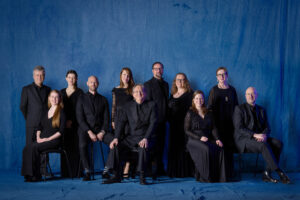
Photo: Hugo Glendinning
On December 5th at Church of St. Mary the Virgin in midtown, Miller Theatre’s Early Music Series presented The Tallis Scholars, directed by Peter Phillips. A nearly annual occurrence, the group often performs Renaissance music with a Marian subject.Last year the visit of angels to the shepherds provided different repertoire that included stirring music by Clemens non Papa. This year, the group focused on chant and chant-inspired pieces from the Christmas season that ranged in date from the 11th to the 21st centuries.
The theme for the concert was In dulci jubilo, and it began with two verses from the eponymous work by Hieronymous Praetorious (1560-1629). The plainchant In principio omnes by the cloistered nun and polymath Hildegard von Bingen (1098-1179) followed, with sopranos from the choir performing the chant and the rest holding a drone in octaves. Shifting to the later Renaissance, Salve Regina by Giovanni Pierluigi Palestrina (c. 1525-1594) alternated between canonic and tutti passages. It was followed by another chant by Hildegard, O virtus sapientiae, performed by the group’s women. Hildegard’s chants can be rangy, and the solid tone from top to bottom was impressively blended. Two more were featured later on the program, O ignis spiritus, in a poised solo by alto Elisabeh Paul, and a group performance of O ecclesia oculi tui.
Peter Phillips has written about the difficulties posed by the music of Orlando de Lassus (c. 1532-1594). Its ranges benefit from the incorporation of instruments on some of the parts, but the composer’s Nunc dimittis ‘Il Magnanimo Pietro’ sounded incredibly assured. Its performance was one of the best of the polyphonic music on the program.
The works of a living composer were also included. The Estonian Arvo Pärt (b. 1935) has been championed by the Tallis Scholars, who have recorded a disc of his music. Pärt writes in a bespoke style he calls tintinnabuli, where the titular bell sounds are created by two voices, one singing a linear, chant-like part, and the other arpeggiating triads. The result is lustrous with tangy dissonances. Magnificat is one of his best known pieces, and the Tallis Scholars performed it with superb tuning and imposing fervor. Da Pacem Domine was written in 2004, and dedicated to victims of the Madrid train bombings. Chords cascade between voices, including a downward lamento motive.
The program’s subordinate theme was Salve Regina, one of four antiphons dedicated to the Virgin Mary. In addition to the Palestrina motet, the group sang the antiphon and two other motets incorporating the chant. Salve Regina by Hernando Marco (c. 1532-1611) is among the first music written in Guatemala, and formidable in its demands. Tomás Luís de Victoria’s Salve Regina is a double choir piece in which the chant’s incipit begins the piece and the chant is threaded throughout the polyphony, ricocheting between the singing groups.
The program finished with a nineteenth century version of In dulci jubilo by Robert Lucas Pearsall (1795-1856), a colorful anthem featuring a tune that has remained part of the hymnody of various denominations. The encore returned to Praetorious for his setting of Joseph lieber, Joseph mein, concluding in a gently lyrical fashion. The Tallis Scholars at St. Mary’s always brings a welcome start to the season with a bevy of glorious singing.
-Christian Carey
